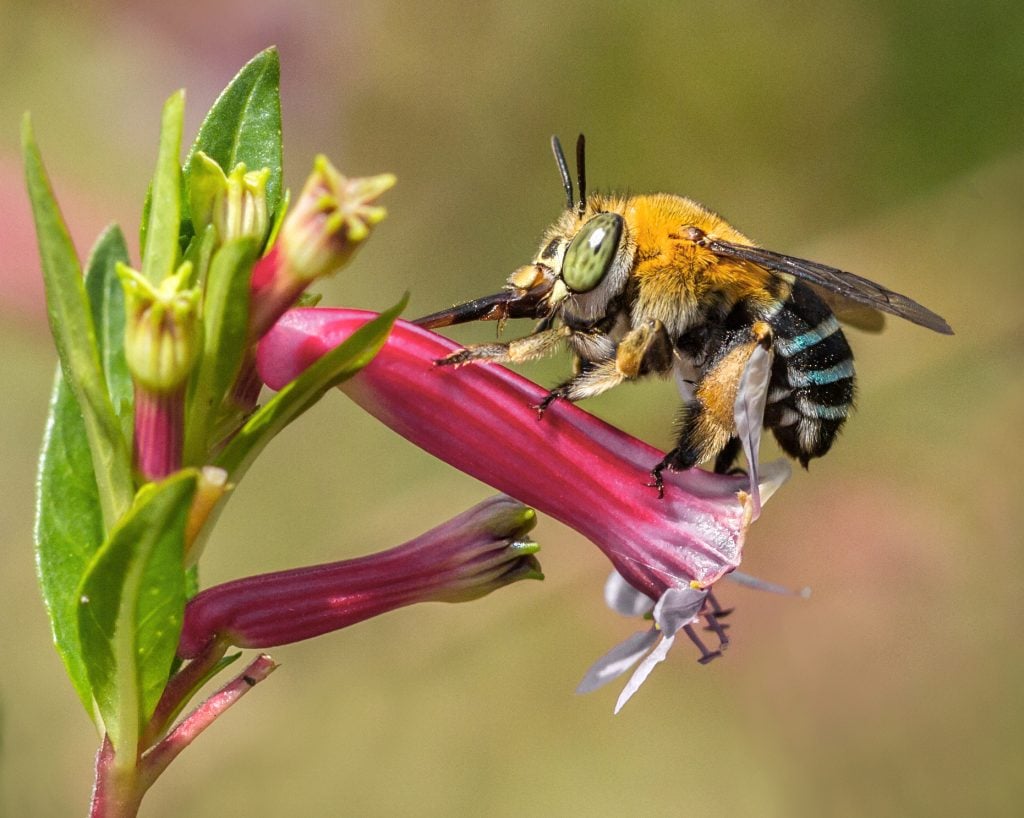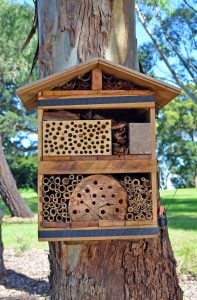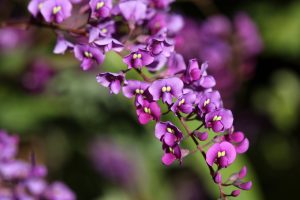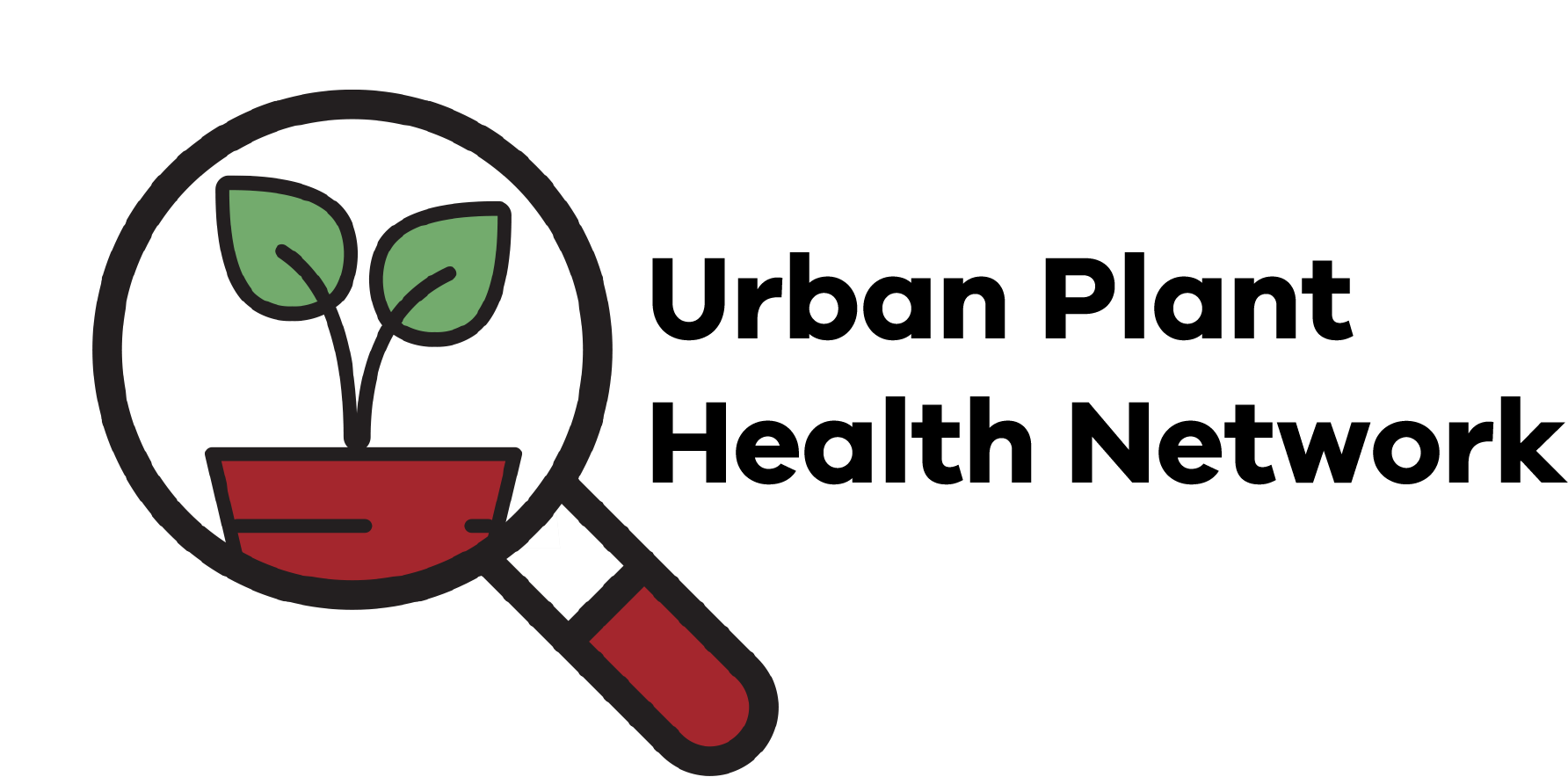
Amegilla cingulata – Blue-banded bee. Image credit: Erica Siegel
If I were to ask you what a native Australian bee looks like, what would you say?
To give you a hint, there is no clear answer! In Australia we have over 1600 species of native bees, and they are as varied in their body types and behaviours as you can imagine. One thing they do share in common is their role as pollinators.
In the early 19th century the European honey bee (Apis melifera) was introduced into Australia. They are a species that has become known as the quintessential bee (and perhaps the European honey bee came to mind when you read the title of this article). However, while the European honey bee has become a crucial component of food production in Australia, and indeed around the world, they are by no means the only method by which our plants are pollinated.
The biology of our native bees (what they get up to day to day) remains poorly understood, and it is likely that their contribution to gardeners and farmers as pollinators is under recognised. Unfortunately, as with many other species, habitat removal and degradation is likely having an impact on our native bee populations.
What native bees can you expect to see around Melbourne?
We have a huge variety of bees, and there are likely many that remain uncharacterised. Our native bees can range from 1.8mm in body length (truly!) to larger than a European honey bee. For the most part native bees are solitary, particularly in cooler climates, so you won’t see any large hives and the busy buzzing of honey-makers around to point you in the right direction. In fact, most do not make ‘honey’ as we know it. But it’s not all about honey right? Native bees, and other pollinators, are an important ‘glue’ in the ecological webs that keep our gardens healthy and productive.
One native bee indigenous to South East Australia that many would recognise is the blue banded bee (Amegilla cingulata) – a very attractive solitary bee, of about 11mm in length and sporting vibrant blue banding on its abdomen. What I love about this bee is its method of pollination. It has been found to be an extremely good pollinator of horticultural crops, such as tomatoes. One reason for its success is due to a unique method of buzz pollination. The blue banded bee will grip the flower with its forelegs and, like a rockstar, bang its head against the anthers at up to 350 times per second! If you would like to know more about the blue banded bee, you can look up the Dr Katja Hogendoorn research group from the University of Adelaide.
How can I help our native bees?
Once you have learnt a bit more about native bees you can inform your friends about these little guys! They’re usually pretty tiny and may quite literally fly under your radar. The more people that recognise our native bees, the more action that can be taken to create native bee friendly habitats.
That takes me to my next point – creation of habitat that supports both native bee reproduction and feeding is crucial. Some native bees will burrow under soil to lay a brood, while others will find crevasses and small holes where they will lay their brood and then seal up the entrance. Investigate what native bees are likely to be found in your area (your indigenous bees) to determine what kind of habitat you should build for your bees.
You may have heard of a ‘bee hotel’. These are generally blocks of wood with small holes drilled in. These are easy to build, and you can even find them at local markets or online. If you are handy you can make

An example of a bee hotel.
your own by drilling small holes in old tree stumps or blocks of wood (make sure your holes are about 5cm deep and no more than 1cm wide). It’s not unusual to see these holes ‘plugged’ soon after a bee hotel is inserted in the garden. This means that the hotel has a little bee resident – good work!
You will also want to investigate your indigenous flowering plants that may be used to support your native bee population. Our native bees have co-evolved with our indigenous plants and have developed methods to effectively feed local species. Plant indigenous flowering species and aim for staggered seasonality of flowering so there is always some pollen, nectar and protein on offer. You may even want to plant a border of flowering indigenous plants around your fruit trees or vegetable patch to encourage these nifty little guys to help you achieve the best yields!
Some attractive options for a border of indigenous flowering plants in Melbourne include:
Hardenbergia violacea (native coral pea)
Pandorea pandorana (wonga vine)
Correa reflexa (native fuscia)
Goodenia ovata (Hop Goodinia).
After boosting the nectar and pollination power of your garden the best way to catch a glimpse of our native bees is to be patient and observe the flowers in the gardens around you.
Happy planting!

Hardenbergia violacea – native coral pea
Your Bee Biosecurity Bite
- While not a native species, the European honey bee does remain an important cog in Australian food production systems (this of course includes honey, and many other tasty foods!)
- There are damaging honey bee diseases and pests overseas from which Australia is free.
- The varroa mite is one pest causing significant damage to European honey bee hives overseas but is not found in Australia.
- If you are an urban hobby bee keeper, ensure you understand how to identify varroa mite and who to call if you suspect an incursion.
- Watch this seminar What’s the Buzz on YouTube for information on Varroa mite, other bee diseases to keep a look out for, as well as information on native bees.
- If you own European honey bee hives, you must be registered with Agriculture Victoria. You can do so by visiting Agriculture Victoria or by calling 136 186.
Found something odd? Call your friendly neighbourhood biosecurity officer on the Exotic Plant Pest Hotline – 1800 084 881
The author would like to thank Dr Ken Walker, Senior Curator of Entomology at Museums Victoria, for providing comment on this article.
Your reading list for this month
Switzer, C., Hogendoorn, K., Ravi, S., & Combes, S. (2016). Shakers and head bangers: differences in sonication behavior between Australian Amegilla murrayensis (blue-banded bees) and North American Bombus impatiens (bumblebees). Arthropod-Plant Interactions, 10(1), 1-8.
Houston, T. (2018) A Guide to Native Bees of Australia. CSIRO Publishing
Also check out Gardening Australia, SERIES 28 – Episode 20 ‘Bee Hotel’
